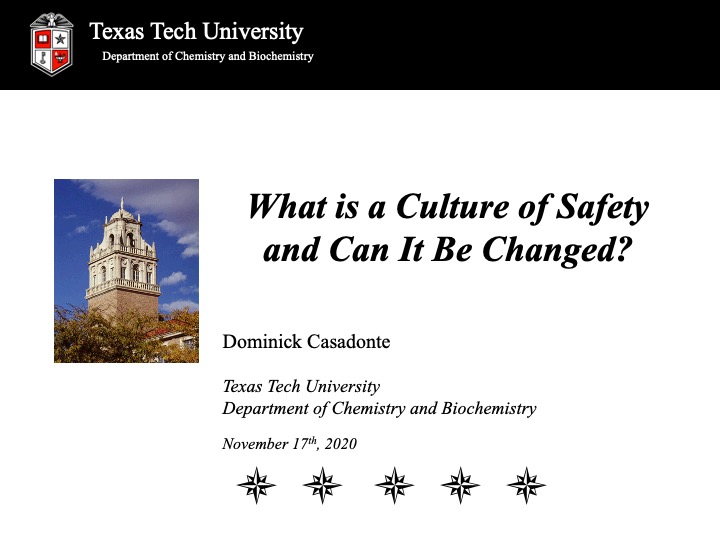Led by:
Dominick Casadonte, Texas Tech University Department of Chemistry and Biochemistry
You can download Dr. Casadonte’s powerpoint file here.
[office_doc id=5125]
Resources discussed in the talk:
- 2011 Report on the Texas Tech University Chemistry Lab Explosion: https://www.csb.gov/texas-tech-university-chemistry-lab-explosion/
- 2013 College and university sector response to the U.S. Chemical Safety Board Texas Tech incident report and UCLA laboratory fatality: https://pubs.acs.org/doi/abs/10.1021/acs.chas.8b20206
- 2020 Ten Years After the Texas Tech Accident: Part I: A Historical Retrospective: https://pubs.acs.org/doi/abs/10.1021/acs.chas.0c00027
- 2020 Ten Years after the Texas Tech Accident. Part II: Changing Safety Culture and the Current State of Academic Laboratory Safety at Texas Tech University: https://pubs.acs.org/doi/abs/10.1021/acs.chas.0c00047
- Dr. Casadonte also served as Dr. Megan Gonzalez’ research advisor for her dissertation “Defining academic safety culture: A national study.” This dissertation includes one of the definitions of Safety Culture Jessica discussed at the beginning of this series: https://ttu-ir.tdl.org/handle/2346/84999
CONVERSATION HIGHLIGHTS
When an accident like this (2010 Texas Tech) happens, it is a system failure.
Before the 2010 accident, we had a lackluster safety committee; it was a way to be on a committee, but not do any actual work.
EHS now has a much heftier line item in the budget for safety.
Faculty, staff, and graduate students are required to take and pass a biannual safety exam. The exam is randomized each time a person takes it from a question bank of ~250 questions. Everyone is required to take this biannually.
Q: What are the consequence if a faculty member does not pass the biannual test?
A: Taking and passing the test is tied into the HR system. If they don’t complete it, they don’t get paid. We had a little trouble in the beginning, but now have 100% compliance.
Texas Tech does not have unions.
The average lab group at Texas Tech has ~10 people in it.
Now working on developing effective “safety award” programs to use as carrots in the system.
Q: Could the safety award programs introduce perverse incentives?
A: We haven’t yet seen evidence of this. A faculty representative from every lab/work area with a safety concern is represented on the committee, so the test has broad support.
Q: Have you employed any means of measuring the graduate researcher perspective on the changes that have been made at Texas Tech since the 2010 incident?
A: When writing the 2 perspective articles for ACS Chemical Health & Safety, we decided not to include the graduate student who was injured due to concerns of re-traumatization. We have also not really introduced a specific way of tracking graduate student perceptions. Obviously, we would not have a graduate student population who would have been there for 10 years to compare the time before the accident and now. However, it is interesting to consider if there is some way to capture that perspective to see if graduate students do notice the changes that we have made. Things definitely “feel” different, but have not formally tracked it in any way.

